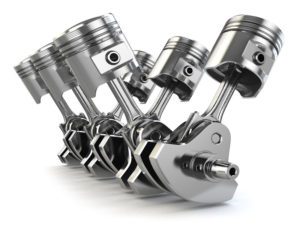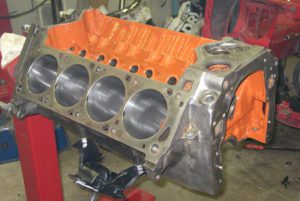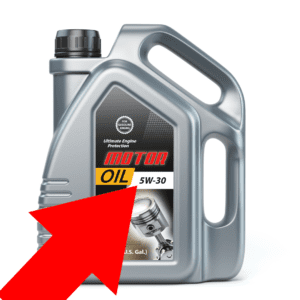
Crawford’s Auto Repair offers engine repairs and lubrication services to vehicle owners from Chandler, Gilbert, Sun Lakes and nearby areas of the East Valley.
Schedule An AppointmentCrawford's Auto Repair can perform all engine repairs, up to and including an engine rebuild if needed. Whether your engine just needs an oil change or extensive repairs, bring it to the shop today for affordable 5-star service. Call 480-201-0740 to schedule an appointment.

V6 Engine Pistons and Crankshaft
The automobile engine consists of a steel block with cylinders, piston head, intake valves, pistons and a crankshaft. It’s called an “internal combustion engine” because a series of controlled micro explosions occurs within the cylinders to drive the pistons up and down. This series of events is called the “Otto cycle” in regular gasoline engines and the “diesel cycle” in diesel engines. For an alternate description of the Otto cycle see Lesson 5 of our Beginner’s Guide To Auto Maintenance & Repairs online or download our free ebook.
The pistons are connected to a crankshaft in an alternating pattern so that when one piston goes up, the adjacent piston goes down. As they alternate going up and down they rotate the crankshaft. The rotational kinetic energy of the crankshaft is then transferred to the wheels through the drivetrain to drive the vehicle forward. When the engine and drivetrain are considered together they are called the power train.

Bare Block of a V8 Engine with empty cylinders.
The internal combustion within the engine is created by igniting an air fuel mixture with a spark in regular gasoline engines. (In diesel engines the ignition is accomplished with compression). So at one point during the cycle, air and fuel are drawn into the cylinder through intake valves, then at another point the the air-fuel mixture is ignited. This all has to be done in sequence repeatedly, so that the fuel injectors inject the fuel with the proper timing and the spark plugs create the spark with the proper timing. This is accomplished with a camshaft and timing belt. The intake valves open in sequence as the camshaft turns and the camshaft turns in synchronization with the crankshaft due to the timing belt.

Diagram showing the operation of a 4-stroke spark ignition engine. Labels: 1 ‐ Induction, 2 ‐ Compression, 3 ‐ Power, 4 ‐ Exhaust. CC-BY-SA 3.0 Zephyris
Since the engine has lots of moving parts moving rapidly it needs lubrication to reduce friction. Therefore, engines are lubricated with oil. Also, the cooling system uses coolant which is a special fluid that can capture and release heat. The coolant travels through channels in the engine where it captures the heat, then travels to the radiator where it releases the heat.
After the air-fuel mixture is ignited, the remaining product is a gas. In order to avoid building up pressure this gas needs to escape the cylinders, which it does through the exhaust system.
Technically the engine itself is the steel block with cylinders, piston head, intake valves, pistons and a crankshaft. The piston head is not the big round portion of the piston that goes up and down in the cylinder; the piston head is actually a block piece which is mounted on top of the engine block and which actually forms the top part of the cylinders. All the other systems are accessories to keep the internal combustion cycling smoothly.
When discussing repairs, the phrase “engine repairs” could refer to all these systems, especially if there is multi-system failure, or it can refer to any of these individual systems: electrical system, fuel system, cooling system, and exhaust system. This page will discuss maintenance and repairs for the engine itself. For further details see also the pages for each of these systems:
- Electrical System – Starter, Ignition, & Charging Systems
- Fuel System
- Air Intake System
- Cooling System
- Exhaust System
Engine Maintenance & Lubrication
The hallmark of all automotive maintenance services is an oil change. As the oil gets used and as it ages it becomes less efficient in lubricating the engine. It can also accumulate micro debris and dirt which can damage the engine. So according to the vehicle manufacturer’s maintenance schedule it is changed frequently at specific mileage intervals. Driving habits and environmental conditions can affect how often the oil should be changed. So the manufacturer often outlines a “standard” and a “severe” maintenance schedule. In the Arizona heat and in the frequent stop-and-go traffic that we experience in the Chandler-Gilbert area, the mileage interval is usually suggested at 5,000 miles for most modern vehicles.
The reason the oil change is the hallmark maintenance service is because it is done on a regular schedule and because all other maintenance for the vehicle occurs with it – that’s if the mechanic is properly considering the vehicle as a whole. This is an important point for the DIY home mechanic. Indeed, there are some who prefer to do oil changes at home to save money; that’s fine if they do it properly. But they often neglect other parts of the vehicle.
At Crawford’s Auto Repair we don’t just do an oil change, we have an oil change and works package. This means we do the oil change and have a systematic check on all vehicle systems, including a test drive, fluids check, safety check and visual inspection of the entire vehicle under the hood and with the vehicle raised on hydraulic lifts. Beyond the engine and accessory engine systems, it’s also important to maintain the drivetrain and brakes for vehicle operation and safety. See the following pages for more information:
- Oil Change & Works Package
- Vehicle Fluids Maintenance
- Safety Check
- Auto Maintenance
- Transmission and Drivetrain
- Brakes
What Does The Number Mean On The Oil Bottle?
 The recommended oil type and specification for your vehicle can be found in the owner’s manual. Another place to find it is on the oil fill cap. It will be based on the ambient temperature where you live. There are two engine oil codes that the owner’s manual will specify, an API and an SAE.
The recommended oil type and specification for your vehicle can be found in the owner’s manual. Another place to find it is on the oil fill cap. It will be based on the ambient temperature where you live. There are two engine oil codes that the owner’s manual will specify, an API and an SAE.
All oil has an API code which stands for American Petroleum Institute. It’s a service rating for the quality, cleanliness, and types of detergents in the oil. The code will always be two letters.
The SAE is the viscosity or thickness of the oil. Modern oil is multi-viscosity oil. The SAE may be something to the effect of 5W-30. The first number-letter combo (5W) indicates the viscosity or thickness of the oil when it is cold. The second number is the viscosity at the engine operating temperature. Before they had multi-viscosity oil there was only single-viscosity oil (SAE 30 for example), which in cold weather is extremely thick. Trying to pour it into your engine would be like pouring honey, and more precisely it would be hard to pump the oil and lubricate the engine. That’s why older engines had to be warmed up before you could drive them, and that’s why multi-viscosity oil is so useful now.
What Is An Engine Tune-Up? Do I need one?
Traditionally an engine tune up is considered to be a spark plug replacement service, but it can also be called a “combustion cycle optimization and timing service”. It replaces certain parts of the electrical system and the engine to make sure the firing order continues to function properly.
A tune-up was an annual maintenance requirement for older vehicles. Modern vehicles may not need tune-ups for 100,000 miles. The specific intervals for your vehicle will be listed in the owner’s manual.
If your engine is exhibiting the following symptoms then it may also be time for a tune up, although that’s something we would verify through an inspection:
- The Check Engine Light is flashing, indicating that there is a misfire (see also Check Engine Light Diagnostic)
- The engine is rough while idling
- Vehicle jerks on acceleration
- Stalling
- Reduced fuel mileage
See the Tune-Up page for more details. Also see Electrical System Service.
Dashboard Indicator Lights For The Engine
There are various dashboard indicator lights which help to monitor vehicle systems. Some of them are emergencies, which means you should pull over safely and quickly to prevent sever engine damage. These are the ones you should memorize so that you know what to do if they come on. Some indicator lights are not emergencies but urgent. If they are ignored over time then they can lead to further damage and more costly repairs. There are also lights which indicate that routine maintenance is due.
Lights You Should Memorize – Pull Over Now
Oil Pressure, Oil Temperature, Engine Temperature
![]()
![]()
![]()
These are the lights you should memorize. There are additional ones you should memorize but these are the ones related to the engine and lubrication. From left to right they are the oil pressure light, the oil temperature light and the engine temperature light. There may also be a gauge for the engine temperature. All of these mean you should stop driving now. Pull over as safely and as quickly as possible. Check your specific owner’s manual for variations because your dashboard lights could be different.
Not Emergencies, But Still Urgent
Check Engine Light
![]()
![]()
![]()
![]()
![]()
![]()
![]()
Obviously a page that discusses engine maintenance and repairs can’t ignore the Check Engine Light. This light is associated with multiple engine systems. If this light is illuminated you will not pass emissions. When it’s flashing it likely means there is a problem with the engine firing order. Learn more about this light and the Check Engine Light Diagnostic.
Low Oil Level Light
![]()
![]()
These are engine oil level lights. The underlying reason why the engine oil is low should be determined; there may be a leak somewhere that needs to be fixed. Note how similar the one with the oil can is to the one that should be memorized.
Oil Maintenance & Oil Sensor Fault Lights
![]()
![]()
![]()
These next three are similar to low oil level lights but they have specific meanings. The first is a check oil level light. It could be a maintenance light. The second is a minimum oil level light which means you have the lowest operating level in range. The third is an oil sensor light which means you don’t know if you have low oil or not, because the sensor is faulty.
These next lights deal with accessory systems to the engine. If they are illuminated they need to be investigated and if they are ignored the deferred maintenance can affect the engine.
Low Coolant Level Light
![]()
![]()
![]()
This is a low coolant light. There are a few variations of this light so check your owner’s manual. If the coolant gets too low then your engine could overheat and damage the engine. If the engine temperature light isn’t on then it’s not critical yet, but it could become critical.
Charging System Warning Light
![]()
![]()
This is a recharging system light, possibly there is something wrong with the alternator, so your battery won’t get recharged. If it illuminates while driving then the engine could stop at any time so it’s best to find a place to pull over if needed.
Fuel Filter Warning Light For Diesels
![]()
![]()
![]()
This a fuel filter light that is unique to diesel engines and it indicates that the fuel filter needs to be changed.
Catalytic Converter, Oxygen Sensor
![]()
![]()
While the Check Engine light monitors anything that can affect emissions, these symbols are directly related to the exhaust system. The one on the left is a catalytic converter warning light. The one on the right is a Lambda Sensor Warning which means the exhaust gas oxygen sensor is dirty or inoperative..
Master Warning Light
![]()
![]()
![]()
This is a master warning light. If you have one in your particular vehicle then it may come on in addition to a warning light for a specific system.
Check Gauges Light
![]()
![]()
These are also general lights which are telling you to check your gauges. Particularly check the oil pressure gauge and engine temperature gauge.
Lights That Indicate That Routine Maintenance Is Due
Routine Maintenance Lights
![]()
![]()
![]()
![]()
![]()
![]()
All these lights indicate that routine maintenance is due, the most common routine maintenance being an oil change.
Air Filter Light
![]()
This light indicates that the air filter needs to be changed. The air filter cleans the air before it’s taken into the engine cylinder for internal combustion.
See additional warning lights on the Dashboard Indicator Light Guide.
Signs Of Engine Failure Which Merit Investigation & Repair
The following are signs of an engine block failure or piston head failure:
- Poor engine performance (could also indicate the transmission)
- Visible engine smoke
- Engine smoke is white
- Engine overheating (Temperature gauge in red zone, temperature light illuminated, see more indications on Cooling System page)
- Leaking oil or coolant
- Low levels of oil or coolant discovered upon inspection
- Excessive smoke from exhaust
- Check Engine Light is on
- Poor fuel economy
The following are signs of crankshaft failure:
- Check engine light is on
- Vibrations in the engine
- Slow response from accelerator
- Erratic starting
- Misfiring of a cylinder
- Stalling and backfiring
A lot of these are similar to other engine systems like the drive train and the cooling system, so part of the technician’s job is to determine the source of the symptoms.
Engine Repairs – Repairs To Engine Parts Or The Engine Itself
Repairs for the accessory systems to the engine (Electrical System, Fuel System, Cooling System, Exhaust System) are much, much more common than repairs to the engine itself. This is partially because it takes less expertise to fix the accessory systems. It’s also because repairs to the engine are more costly than repairs to the accessory systems. Common repairs that are called “engine repairs” might include an ignition core replacement, but these are part of the electrical system. For specific repairs on each of these systems visit each of these pages:
- Electrical System – Starter, Ignition, & Charging Systems
- Fuel System
- Air Intake System
- Cooling System
- Exhaust System
Rest assured Crawford’s Auto Repair has the expertise to repair the engine block itself and if it’s determined that this is the best course of action for you, then we’d be happy to help. Our technicians don’t just work here, they build race cars as hobbies. They know auto mechanics from the inside out and back inside again.
An engine oil leak repair would involve an inspection to discover where the leak is happening and then repairing the part or replacing it. This may be a simple fix like piston head gasket replacement. It’s unlikely that a piston would break without also doing damage to the cylinder in which it resides. That would require piston head replacement as well as reconditioning of the cylinder in the engine block. If the piston head is leaking then it would require piston head reconditioning or replacement.
If the engine block is leaking or cracked then it would require engine block reconditioning or replacement. Sometimes the cracks can be fixed with welding (hot) or pinning (cold) but if they can’t then the you’ll need engine replacement. The engine block and piston head are complex pieces of thick steel. Some cracks can be repaired and others can’t.
Sometimes an engine replacement can cost the same as a whole new vehicle so if it comes to this then we’ll discuss best options with you to move forward.
Here is a more complete list of repairs for the engine itself:
- Engine mount replacement
- Engine reconditioning
- Engine rebuild
- Engine replacement
- Engine block reconditioning
- Engine block repair
- Piston head reconditioning
- Piston head repair
- Piston head replacement
- Piston head gasket replacement
- Piston replacement
- Crankshaft harmonic balance replacement
- Front crankshaft seal replacement
- Valvetrain repair
- Distributor O ring replacment
- Distributor replacement
- Distributor cap replacement
- Valvetrain replacement
- Crankshaft position sensor replacement
- Crankshaft repair
- Engine oil leak repair
- Engine oil service
- Engine oil replacement (oil change)
- Oil change and works package
- Engine intake valve leak repair
- Engine intake valve replacement
- Engine overhaul
- Engine tune up
- Oil pan replacement
- Oil pan gasket replacement
- Timing belt replacement
- Camshaft position sensor replacement
- Top dead center (TDC) sensor replacement
- Oil temperature sensor replacement
Call 480-201-0740 to schedule an appointment for Engine Repairs and Lubrication.
Looking for a shop that can do engine repair, rebuilds or replacement? Are you due for engine maintenance or an oil change? Then bring your vehicle to Crawford’s Auto Repair. We’ll treat your vehicle as if it belonged to our own mother and we never try to sell unecessary repairs. Get affordable 5-star service today. If you ever feel like you didn’t receive 5-star service then let us know and we’ll do what we can to make it right. Call 480-201-0740 to schedule an appointment.


No Comments
Sorry, the comment form is closed at this time.